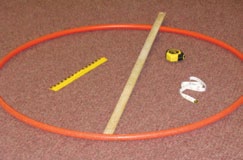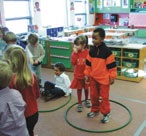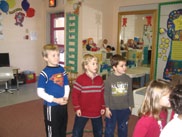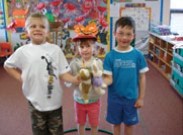E2. Measurement
Compare, estimate and determine measurements in various contexts.
Learning Situation: Budding Scorers
Total Duration: approximately 1h 30 min
Summary
In this learning situation, children compare objects by exploring the attribute of length. They use different parts of their bodies and concrete objects as non-standard measuring tools. Children then compare the length of these tools (non-standard units of measurement) with the lengths of stuffed animals and children.
|
Overall Expectation |
Specific Expectations |
|
E2. Measurement Compare, estimate and determine measurements in various contexts. |
E2.1 Identify measurable attributes of two-dimensional shapes and three-dimensional objects, including length, area, mass, capacity, and angle. E2.2 Compare several everyday objects and order them according to length, area, mass, and capacity. |
Learning Goals
The purpose of this learning situation is to have the students:
- compare objects by describing them using measurement vocabulary such as longer than, shorter than, of the same size as;
- measure the length of objects using benchmark objects;
- order objects according to the length attribute.
|
Learning Context |
Prior Learning |
|
All measurement involves comparison. To determine the measure as an object's attribute, it is compared with the same attribute in a non-conventional or conventional unit of measurement. For example, the length of an object can be determined by using the length of a benchmark object, such as an eraser (non-standard unit) or by using a standard unit of measurement, such as centimeters (cm). Children routinely measure objects in their daily activities using a variety of attributes, such as length, mass, or capacity. It is important to support students in identifying the attribute that is being measured, and to explore with them the meaning of the word measure, prior to teaching them any measurement techniques or procedures. |
To be able to perform this learning situation, children must be able to:
|
Material
- soft toys
- various objects
- Appendix 1
- crowns or hats (one crown or hat per group of three students)
- large hoops of the same colour (one per group of three students)
- retractable measuring tape
- measuring tape
- metre stick
- 30 cm ruler
- choice of music
Benchmark object: an object for which a certain attribute will become the child's personal unit of measurement. For example, a child chooses a pencil to measure the length of a book. The pencil is the benchmark object, its length is the unconventional unit of measurement for that child.
This learning task includes an optional activation activity section, a before learning section and two active learning sections, each of which is followed by a consolidation section. Two additional activities are then proposed.
Mathematical Vocabulary
small, long, short, same size as, longer than, shorter than, benchmark object, size
Optional Activation Activity
Duration: approximately 10 minutes
Invite children to sit in a large circle. Place enough hoops inside the circle to allow children to form groups of two, three, or four children. Explain to children that you are proposing a game similar to musical chairs. Invite children to move around the hoops to the sound of the music and, when the music stops, to form groups of two, three or four children inside the hoops according to the instructions given.
When the music stops, the teacher may give or sing a directive such as:
- We've work to do, we are two.
- A group of three, that is key.
- We do more, when we are four.
Before Learning (Warm-Up)
Duration: approximately 15 minutes
A few days before the activity, provide the children with Appendix 1, which consists of a letter asking parents to allow the children to bring a stuffed animal to school.

On the day of the activity, first place various conventional measuring instruments inside a large hoop, such as a tape measure, a retractable tape measure, a 30-cm ruler and a metre stick. Gather the children around the hoop and invite them to observe the objects placed in the centre of the circle. Point out that these are measuring instruments by asking questions such as:
- What can we do with these objects?
- Is it possible to measure objects without using these tools? How?
Examples of possible responses from children include:
- We can measure the length of the mat with our fingers, hands, or feet.
- You can measure the length of the board with a toy.
- We can measure the length of the classroom wall by standing next to each other.
Introducing children to conventional measuring instruments should allow them to relate the objects in their environment to the concept of measurement presented in this learning situation. However, these instruments will not be used to make measurements.
Second, have each child present their stuffed animal and find a benchmark object in the classroom to measure it (compare it to). Ask each child to determine whether their stuffed animal is longer or shorter than the benchmark object, and then have them take turns presenting their stuffed animal and benchmark object. Encourage them to use appropriate vocabulary, for example, "my stuffed animal is longer than the pencil," "my stuffed animal is shorter than the paintbrush.).
Challenge the children, "Is your stuffed animal always longer or always shorter than the other children's benchmark objects in the classroom?"
Active Learning 1 (Exploration)
Duration: approximately 20 minutes
Before starting, place a number of hoops on the floor equivalent to one-third of the children in the class, and place a crown or hat on one-third of the children's heads so that they can be easily spotted in the classroom (for example, if there are 24 children in the class, provide eight crowns or hats and eight hoops).
Ask each child wearing a hat to hold the benchmark object they have chosen to measure their stuffed animal and then stand in one of the hoops (one child per hoop). They should leave their stuffed animal aside for now.
Explain to the children that the game they will be playing is similar to musical chairs. When the music starts, all the children – except those in the hoops – dance with their stuffed animals around the hoops. As soon as the music stops, the children must place themselves quickly in the hoops, taking care to form groups of three: the child wearing a crown and holding their benchmark object, a child whose stuffed animal is longer than the benchmark object, and a child whose stuffed animal is shorter than the benchmark object. Once the children have formed a group of three, ask them if the group complies with the guideline. To justify their answers and show that they are following the instructions, the children must use the appropriate vocabulary. A child might say, for example: “Our group follows the rules because my stuffed animal is longer than the truck – the benchmark object – and their stuffed animal is shorter."
Repeat the activity several times with different children wearing the crown or hat. Once designated, the children choose their benchmark object and put their stuffed animal aside. During the game, circulate, observe, and if necessary, help the children form their groups of three and provide their answers.
If a group cannot be formed according to the instructions, the children wait for the next round, but it is important that the children explain why they cannot form a group of three.
|
Possible Observations |
Possible Interventions |
|
A child (or two) does not belong to any group once the trios are formed, due to the length of the benchmark object and their stuffed animal. |
Explain that this can happen because the length of the stuffed toy does not meet the guideline (for example, the remaining stuffed animals are shorter than the benchmark object).  |
|
Two children with shorter (or longer) stuffed animals form a trio. |
Ask questions such as:
 |
|
One child compares their stuffed animal to the other child's stuffed animal in the trio instead of comparing it to the benchmark object. |
Model the comparison of the length of the stuffed animal to the benchmark object.  |
Consolidation of Learning 1
Duration: approximately 15 minutes
When all the children have worn the crown or hat, gather them in a circle and lead a discussion.
Ask questions such as:
- Was your stuffed animal always shorter than the benchmark object? Why?
- Was your stuffed animal always longer than the benchmark object? Why?
- Is it possible that a stuffed animal is always longer than the benchmark object? Justify your answer.
- Is it possible that a stuffed animal is always shorter than the benchmark object? Justify your answer.
- Is it possible for a stuffed animal to be sometimes the longest and sometimes the shortest? How do you know?
Children might give answers such as:
- My stuffed animal was the shortest when the benchmark object was the longest.
- When I was in Jasmine's group, my stuffed animal was the longest because the benchmark object was so short, but when I was in Jeremiah's group, my stuffed animal was the shortest because the other stuffed animal and the benchmark object were longer.
- My stuffed animal has always been the longest because no stuffed animal in the class is longer than mine.
- Sometimes I thought my stuffed animal was longer, but when I put it next to the benchmark object, I saw that it was shorter.
Active Learning 2 (Exploration)
Duration: approximately 15 minutes
Continue the activity by explaining to the children that they will take turns becoming the benchmark object to compare their heights. As soon as the music stops, the children should form groups of three in which one child is taller than the benchmark object child and another child is shorter than the benchmark object child. Ensure that all children wear the crown or hat at least once. Mention that some groups will be difficult to form (for example, if the child who wears the hat is the tallest or shortest child in the class).
|
Possible Observations |
Possible Interventions |
|
One child does not belong to any trio and stays away because of the number of children in the group. |
Explain that this can happen because there are not enough children to form another trio.  |
|
In the same trio, two children are the same size. |
Ask one child to stay in the trio and guide the other to another trio.  |
Consolidation of Learning 2
Duration: approximately 15 minutes
When all the children have worn the crown or hat, invite them to sit in a circle and lead a discussion.
Ask questions such as:
- Are you sure you are the shortest child? How do you know?
- Are you sure you are the tallest child? How do you know?
- Is it possible that you are always the tallest child? Why?
- Is it possible that you are always the shortest child? Why?
- Is it possible that sometimes you are the tallest child and sometimes the shortest child? How do you know?
Here are some possible responses from children:
- I'm sure I'm the smallest because I have the smallest height in the class.
- Pietro is certainly the tallest student because all his friends are shorter than him.
- I may be the tallest child or the shortest child, depending on the size of the child who is the benchmark object.
Clarification for Teachers
It is important to use "large" and "small" to qualify the size, not the child. This is true for all attributes. For example, we qualify the attribute, not the object, by saying that the apple has a larger mass than the orange, not that the apple is larger than the orange. Or, by saying that this container has a larger capacity than another container, not that it is the largest container.
Differentiated Instruction
|
To Simplify the Task |
To Enrich the Task |
|
|
Follow-up at Home
Ask children to draw a picture of their family members and place them in ascending order of size. Also ask them to place their stuffed animals or other toys from longest to shortest. Suggest that they compare the size of various familiar objects (for example, objects found in their room).
Source: translated from Guide d’enseignement efficace des mathématiques, de la maternelle à la 3e année, Mesure, p. 110-118.
